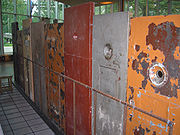
Museum of Occupations
Encyclopedia

Tallinn
Tallinn is the capital and largest city of Estonia. It occupies an area of with a population of 414,940. It is situated on the northern coast of the country, on the banks of the Gulf of Finland, south of Helsinki, east of Stockholm and west of Saint Petersburg. Tallinn's Old Town is in the list...
, Estonia
Estonia
Estonia , officially the Republic of Estonia , is a state in the Baltic region of Northern Europe. It is bordered to the north by the Gulf of Finland, to the west by the Baltic Sea, to the south by Latvia , and to the east by Lake Peipsi and the Russian Federation . Across the Baltic Sea lies...
, is located at the corner of Toompea St. and Kaarli Blvd. It was opened on July 1, 2003, and is dedicated to the 1940-1991 period in the history of Estonia
History of Estonia
Estonia was settled near the end of the last glacial era, beginning from around 8500 BC. Before the German invasions in the 13th century proto-Estonians of the Ancient Estonia worshipped the spirits of nature...
, when the country was occupied by the Soviet Union
Soviet Union
The Soviet Union , officially the Union of Soviet Socialist Republics , was a constitutionally socialist state that existed in Eurasia between 1922 and 1991....
, then Nazi Germany
Nazi Germany
Nazi Germany , also known as the Third Reich , but officially called German Reich from 1933 to 1943 and Greater German Reich from 26 June 1943 onward, is the name commonly used to refer to the state of Germany from 1933 to 1945, when it was a totalitarian dictatorship ruled by...
, and then again by the Soviet Union. During most of this time the country was known as the Estonian Soviet Socialist Republic
Estonian Soviet Socialist Republic
The Estonian Soviet Socialist Republic , often abbreviated as Estonian SSR or ESSR, was a republic of the Soviet Union, administered by and subordinated to the Government of the Soviet Union...
.
The museum is managed by the Kistler-Ritso Estonian Foundation. The foundation is named after Dr. Olga Kistler-Ritso, the founder, president, and financial supported of the foundation. The members of the foundation started to collect articles for the museum and for historical study in 1999. Cooperation was set with Estonian International Commission for the Investigation of the Crimes Against Humanity, the Estonian State Commission on Examination of the Policies of Repression, Memento Association, the Research Centre of the Soviet Era in Estonia, as well as with the Russian Memorial Society
Memorial society
A memorial society can be:*A society established in memory of someone or something, e.g.:**Memorial , an international historical and civil rights society that operates in a number of post-USSR states**Sardar Amir Azam Memorial Society...
dedicated to victims of Soviet repressions, and other organizations.

